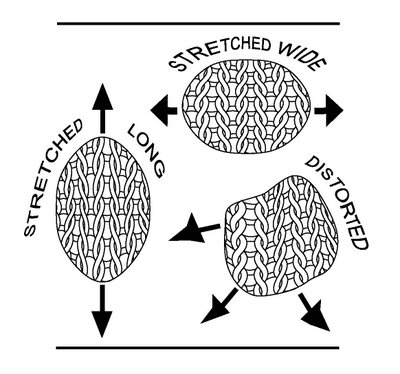Seems like a logical place to start: What IS knitting? How is it constructed? How does knitted fabric differ from cloth? And what's so special about knitted fabric, anyhow?
Knitting is made of a continuous yarn formed into loops, which are drawn through other loops. Each stitch maintains a connection with all the other stitches in its row and in its column, even after the knitting process is complete.
 By contrast, woven fabric is made of cut lengths of thread, which have no connection (other than proximity) to their surrounding threads.
By contrast, woven fabric is made of cut lengths of thread, which have no connection (other than proximity) to their surrounding threads.
Because of knitting's unique structure, it S-T-R-E-T-C-H-E-S. Each stitch traces a loopy path through the fabric, so the yarn lies coiled within the fabric. There is plenty of "reserve" yarn to stretch. Unlike the threads of woven cloth (which trace a straight line through woven fabric) knitting can be stretched wide, or long, or even distorted both ways at the same time.

Knitting's outstanding capacity to stretch means that everyone today wears knits, even people who think they "hate knitting," because knitting isn't just the sweaters created by hand knitters. T-shirts, sweatshirts, underpants, socks are all knitted of very fine yarn on giant machines. When you consider that they had to wear woven fabric against the skin, it's no wonder folks look so crabby in those old-time photos.
Another great thing about knitting is that, because it is connected in the rows, knitting can be raveled out, row by row. This raveling is called "pulling back" or "ripping out." (Some call it "frogging" because frogs say "rip-it, rip-it." Be warned--this is a fair sample of knitting humor.)
Being able to rip out may not seem like much of an advantage, but it is: if you make a mistake, there is nothing to throw out--the yarn can be re-used (very different than the cut threads of weaving). Also, it is possible to snip a stitch and ravel out a few stitches along a row of already-knitted fabric. Snip and pull, and you get a horizontal opening surrounded by the loops of the rows above and below. Put these newly-exposed loops back on a needle, and you can knit in a whole new piece of fabric. This is the secret of after-thought buttonholes, after-thought heels, after-thought pockets, after-thought mitten thumbs.
If you ravel across a whole row, or around a complete round, the knitted fabric splits in two. The loops of either half can be put back on a needle knitted up (or down). This is the way to lengthen already-knit sleeves without pulling them out, or take a worn-out cuff off a mitten and add a new one, as in the picture below.
 A third advantage of knitting's row-and-column structure is that knitting can "run out" in the columns. Once you've seen a run in a nylon stocking or a T shirt, or the laddered mess above a dropped stitch, you may not think of this as much of an advantage, but it is. Drop a stitch down on purpose and you can correct a mistake 20 rows back without ripping back, row by row. Once the mistake is fixed, you can hook the run back up with a crochet hook, ladder by ladder, to the top.
A third advantage of knitting's row-and-column structure is that knitting can "run out" in the columns. Once you've seen a run in a nylon stocking or a T shirt, or the laddered mess above a dropped stitch, you may not think of this as much of an advantage, but it is. Drop a stitch down on purpose and you can correct a mistake 20 rows back without ripping back, row by row. Once the mistake is fixed, you can hook the run back up with a crochet hook, ladder by ladder, to the top. For further information about correcting errors, use the series index in the sidebar to find posts on "correcting errors in the row below."
For further information about correcting errors, use the series index in the sidebar to find posts on "correcting errors in the row below."As to how knitting is created, there are two methods, needle knitting and peg knitting. Hand knitters do needle knitting: as you transfer the loops on the left needle to the right needle, you draw a new loop through each old loop with the tip of the right needle. This continuous web of loops makes knitted fabric.
The most familiar example of peg knitting is spool knitting. Knitting "looms" (which are nothing but much bigger spool knitting frames) are currently a sort of mini-fad at craft and fabric shops. Knitting machines are also peg-knitting devices. On all peg-knitting devices, a separate peg holds each stitch, the yarn is wound around the outside of the peg, and the old loop lifted over the new loop with a "pick" or hook, either manually (spool or loom) or mechanically (knitting machine).
Both needle- and peg-knitting produce the same fabric: loopy, stretchy knitting.
And now, goodnight. My husband is ready to kill me because all these illustrations (not to mention the HTML code) take for-freaking-ever.
--TECHknitter